Now that we have a good understanding of how scientists define birds and other dinosaurs, we are equipped to tackle the real matter at hand. Did any non-avian dinosaurs really have feathers? The answer to this question…is a resounding yes!
Over the past 20 years or so, researchers have discovered a plethora of feathered dinosaurs from bonebeds around the world. Delicate body coverings, such as feathers, are not often preserved in the fossil record. This is because decay processes and the elements can easily destroy such structures. Konservat-Lagerstätte (or conservation lagerstätte) are unique fossil deposits where, for varying reasons, these destructive factors were not as influential. Lagerstätte can be produced in a variety of environments, including submerged basins and areas covered by volcanic ash and other debris. These types of localities offer a window into what long-extinct animals really looked like, often in more detail than we ever could have imagined.
Flurries of Feathered Dinosaur Families
Do you remember the field of taxonomy, our “Russian nesting doll” from part 2? This is how scientists classify living things into nested hierarchies: groups within larger groups within even larger groups. All members of each group either have certain traits that sets the group apart, or belong to a subset of that group that has those traits.
Also recall that Dinosauria (the group containing all dinosaurs) is not a single type of animal like a dog, cat, or horse, but a diverse group of animals, sort of like the term “mammal.” But we can divide Dinosauria into even smaller and smaller groups. Most feathered dinosaurs identified so far belong to a particular group within Dinosauria called theropods. This is the group containing meat-eating dinosaurs, like Velociraptor and Tyrannosaurus. While fossils show that many theropods were completely cloaked in plumage, others were not. So far, researchers have primarily only found feathers among only certain groups of theropods. Scientists find using taxonomy helpful to classify dinosaurs because it allows them to infer which species may have had feathers, even when they do not find actual fossilized feathers preserved on particular specimens.
With this understanding, let’s look at a few of the many groups of dinosaurs known to have feathers from the fossil record:
![By Cladogram by Kiwi Rex - Phylogeny and integument description based on Benton et al. (2019)[1]. Images of scales and feather types taken from this article and File:Distribution of feathers in Dinosauria.jpg. Silhouettes from works by Slate Weasel, Matt Martyniuk, Audrey.m.horn, Tom Parker, Michael B. H. and Gareth Monger[2]., CC BY-SA 4.0, https://commons.wikimedia.org/w/index.php?curid=89515469](https://newcreation.blog/wp-content/uploads/2023/07/1062px-Dinosauria_phylogeny_and_integument-1024x694.png)
Deinonychosauria
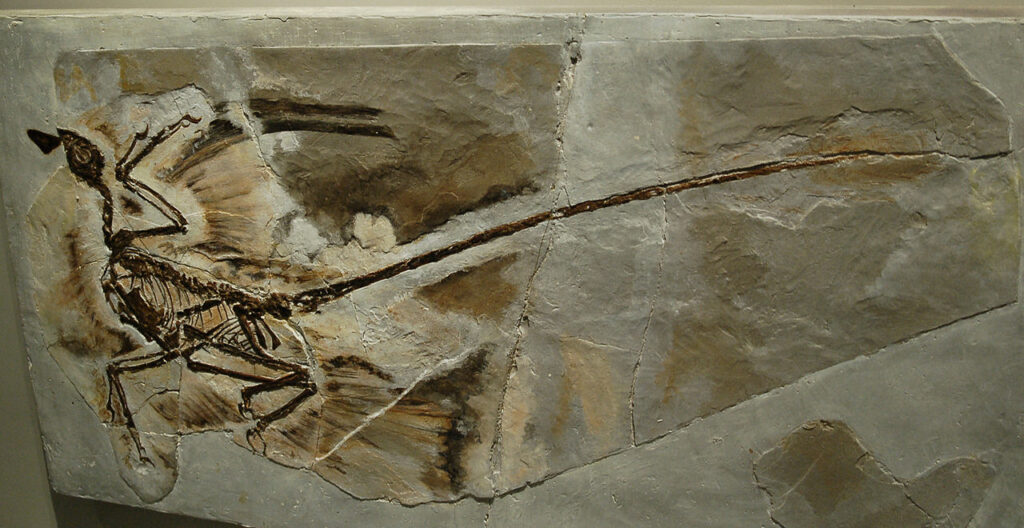
Small to medium-sized, two-legged theropods, deinonychosaurs are well-known for the enlarged, sickle-shaped talon on the second toe of each foot. They also had jaws full of sharp teeth, clawed forelimbs, and a long bony tail for balance. With a wishbone and airy openings throughout the bones of their skeleton, they were incredibly bird-like. Thanks to fossil discoveries in China’s Liaoning Province, we also know that these animals were fully-decked out in feathers.
Discovered in the year 2000, Microraptor fossils showcase long flight feathers anchored not only to its hands and arms, but to their legs and feet as well. This was a four-winged dinosaur. Though often regarded as only capable of gliding, a recent study suggests that Microraptor was capable of powered flight.1 Excitingly, Microraptor’s feathers are so well-preserved that scientists can determine what color they were.2 This is because the feathers contained melanosomes, the cell components that produce pigment in modern bird feathers. By comparing the shape of the melanosomes to those present in modern birds, scientists figured out that Microraptor had a glossy coat of black, iridescent feathers.
Zhenyuanlong is another feathered deinonychosaur discovered in the same region.3 Like Microraptor, it had wings similar to those of modern birds, and it had feathers running down the length of its tail. We can liken it somewhat to a ground-dwelling hawk or eagle. Unlike most birds, however, Zhenyuanlong could not fly. Its wings were too small in proportion to its body size for it to attain lift. Instead, it probably used its feathers like many ground-dwelling birds (such as ostriches) do today. Such behaviors include displaying to other members of its species, sheltering its nest of eggs, and perhaps for steering as it chased after prey.
Oviraptorosauria
Found primarily in Asia, oviraptorosaurs are unique for their unusual toothless beak at the front of their jaws. Some species, such as Citipati, also had a peculiar crest located on the top of the head, probably used for display. This feature varied in size and shape depending on the species. Oviraptorosaurs are also notable because not only do we have direct evidence that these dinosaurs were feathered, but we also have indirect evidence from their behavior as inferred from fossils.
Researchers have found multiple specimens of Citipati crouching over nests of eggs. Their forelimbs adopt a near-folded posture over the perimeter of the nest, and the eggs are in direct contact with the animal’s stomach and feet. This is a brooding posture, just like that seen in birds. Interestingly, this arm position only makes sense if Citipati had wing feathers, otherwise many of the eggs would remain unprotected and exposed to the elements.
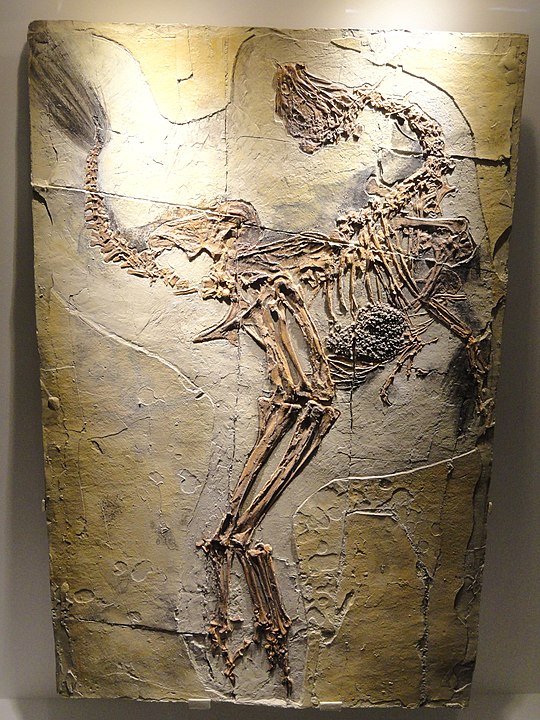
Additional evidence for feathers in oviraptorosaurs comes from well-preserved fossils from the Liaoning Province in China. Caudipteryx was about the size of a turkey. Fossils of this species reveal that it had feathers running down its hands, complete with vanes and barbs.4 There are also feathers forming a fan-like shape on the end of its tail, much like those of a turkey or a peacock. Studies of the melanosomes in the feathers suggest they were black in color, with stripe-like patterns on the tail.5 But Caudipteryx had characteristics that were not like modern birds as well. For example, its pubis was pulled forward, much like a typical theropod (meat-eating dinosaur). Given that this animal’s wings were too small for flight, its fancy feathers were almost certainly just for show. Perhaps they used their wings to put on intimidating threat displays or attracting mates.
Alvarezsauroidea
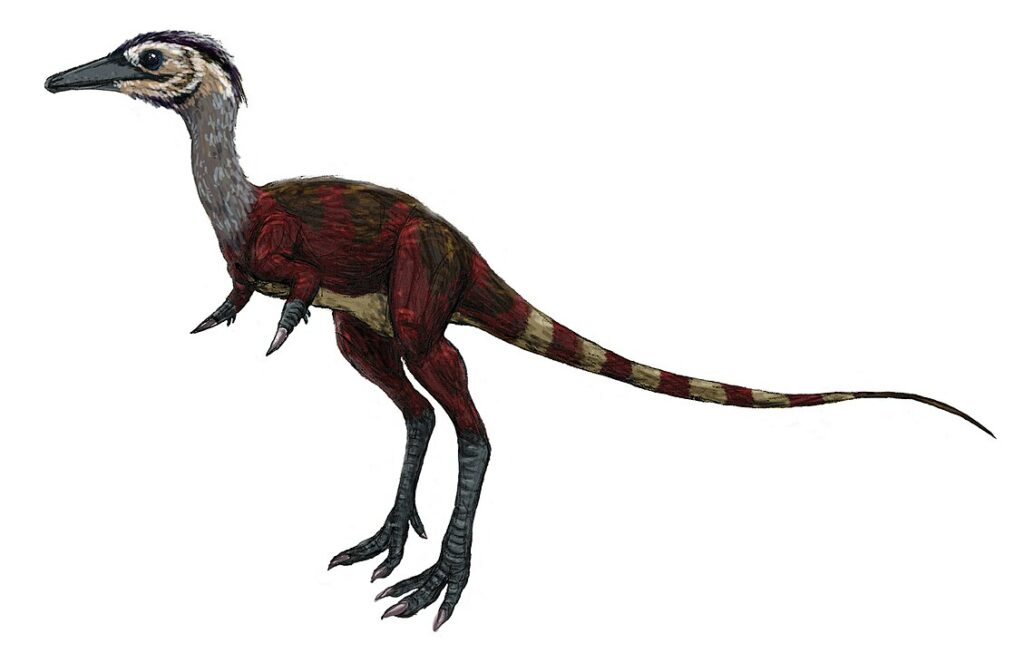
While the smallest known dinosaur, Alvarezsauroids certainly stood out from other therapods with their tube-shaped mouths and tiny forelimbs, each bearing a large, clawed digit (and multiple smaller ones). Scientists debate how the animal used them, but they might have helped the animal excavate ants and termites from their nests. Its miniature hands are compact and very bird-like in appearance. In fact, alverezsauroids were once mistakenly thought to actually be flightless birds by some paleontologists.6 This idea came about because they had many features once thought unique to birds, such as an elongated, deeply keeled sternum for enlarged chest muscles. However, the discovery that only the alvarezsauroid species possessed these bird-like characteristics helped scientists better classify them.7 These animals were not truly birds at all, but feathered non-bird dinosaurs.
Researchers discovered one member of the Alvarezsauroidea, called Shuvuuia, in Central Mongolia. It was about the size of a chicken. One notable specimen of Shuvuuia possesses tiny, tube-like, hollow structures around its body that look like the shaft of a modern bird’s feather.8 Biochemical tests by Dr. Mary Schweitzer and her colleagues demonstrated that the entire composition of these structures was of the protein beta-keratin. Most importantly, alpha-keratin was absent. This is significant because it gives scientists a clue as to the identity of these unusual structures. Reptilian scales consist of both alpha-keratin and beta-keratin. However, bird feathers consist entirely of beta-keratin, and they lack alpha-keratin. This demonstrates that, in life, Shuvuuia bore a coat of simple, filament-like feathers.
Tyrannosauroidea
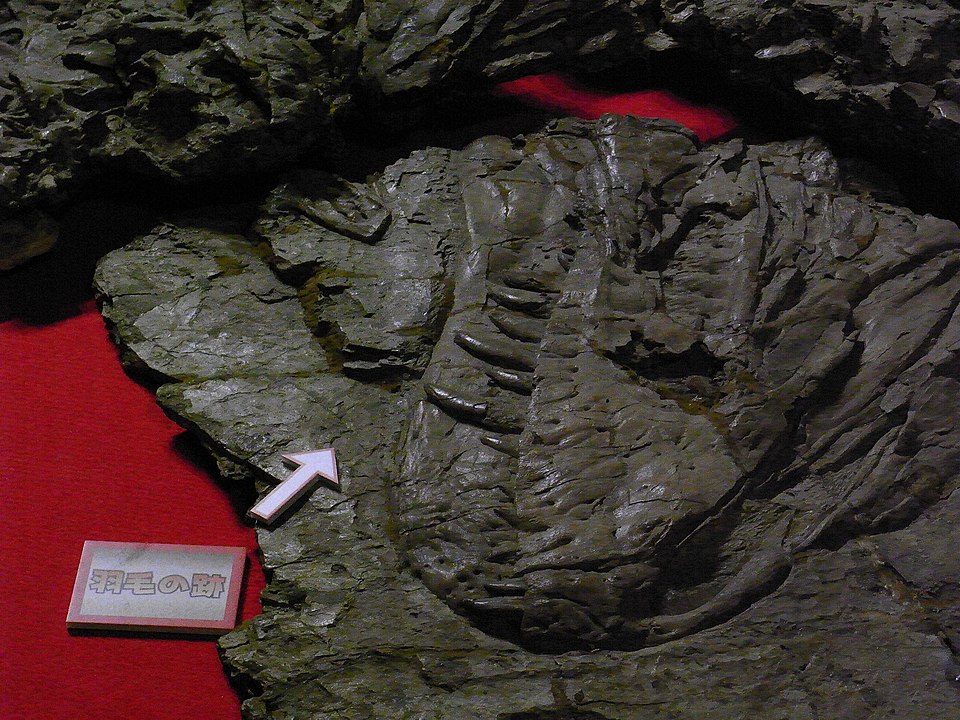
Tyrannosaurs came in a wide range of shapes and sizes, from agile, emu-sized creatures like Eotyrannus to elephant-sized giants like Tyrannosaurus itself. Some of the smaller species had elaborate crests on their heads, likely for display. Others had a bone-crushing chomp capable of pulverizing bone and mouthing 500 pounds of flesh in a single bite.
For a long time, the prevailing view held that tyrannosauroids were completely covered in scaly skin. The discovery of large, scaly skin impressions associated with some tyrannosaur fossils backe. However, more recent fossil evidence has complicated this picture, showing that at least some species within this group had feathers or feather-like structures during certain stages of their lives. Researchers announced Dilong, a small genus of tyrannosaur in 2004, with simple feathers running along its jaw and tail.9 These were more like the downy, insulating feathers of baby birds than flight feathers seen in other dinosaurs.
Before another discovery, announced in 2012, paleontologists debated whether it was just small dinosaurs that had feathers. This changed when fossil hunters found fossils of Yutyrannus, a tyrannosauroid almost as long as a school bus. Feathers on this animal occurred across much of the body, including the neck, arm, feet, pelvis, and tail, the longest of which measure 200 mm long.10 These are not like the feathers like those we typically associate with the word “feather.” Instead, they are slender, unbranching structures.
Why Do Some Tyrannosaurs Have Feathers While Others Have Only Scales?
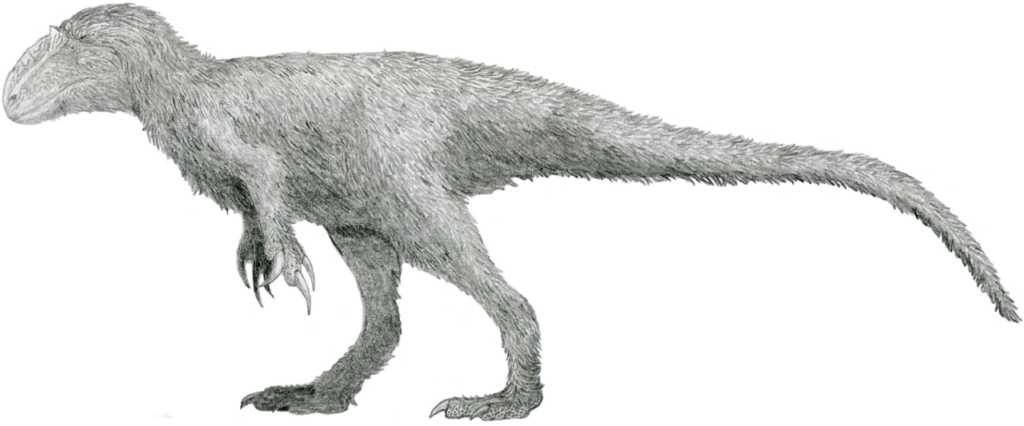
Though scales and feathers seem like quite different, counterintuitive forms of body covering, we have modern day examples where some members of a group of animals have feathers on one part of its body while other members of the same group have scales on the same body part. For example, chickens and pigeons (like most birds) generally have scaly legs and feet. However, certain breeds, like silkie chickens, have feathery legs and feet instead.
The presence of extensive coats of feathers on some tyrannosauroids but not others may have something to do with the environment certain species lived in. Researchers think that Yutyrannus, for example, lived in an environment with more seasonal variation than animals like Tyrannosaurus, for which there is no feather evidence.11 This type of environment is evidenced by the presence of fossilized wood coming from conifers and other trees in the same fossil deposits as Yutyrannus that inhabit temperate, seasonal climates. Also noteworthy are the lack of fossil reptiles that would have needed warm climates to survive, like crocodilians. This suggests the environment in which Yutyrannus lived got too cold for crocodiles and similar reptiles to survive. A coat of feathers would have helped keep Yutyrannus warm during cold winters.
Compsognathidae
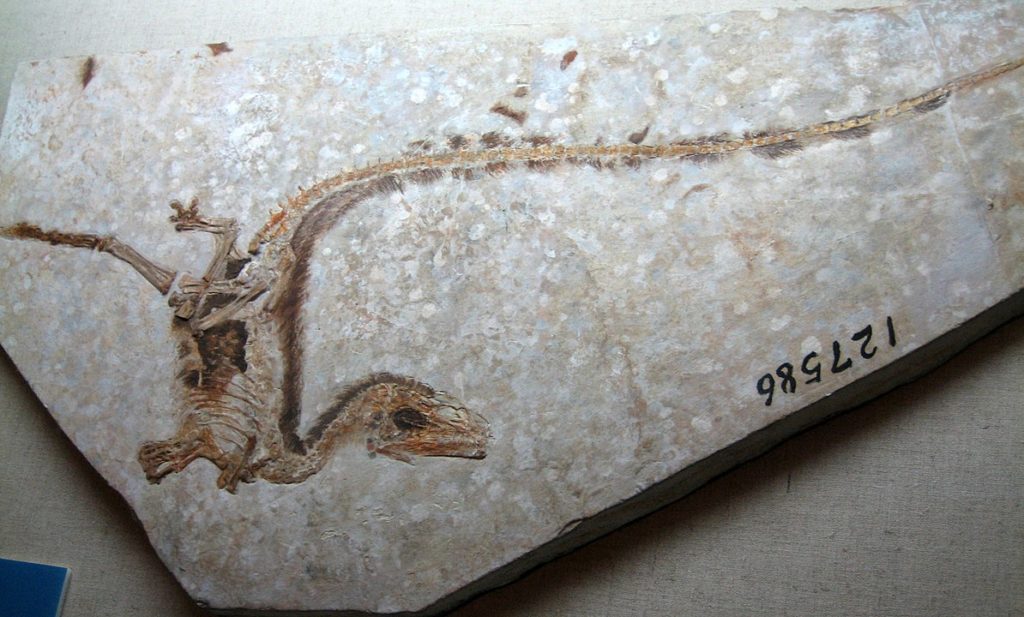
Even though no longer considered the smallest dinosaurs (alvarezsauroids and others are even smaller), compsognathids are still quite tiny compared to other theropods. The most famous member of this group is Compsognathus itself, which grew about the size of a large chicken. Others were larger, like Sinocalliopteryx, which weighed about 44 pounds.
In 1996, scientists found Sinosauropteryx. It was the first feathered non-avian dinosaur discovered after Archaeopteryx, which was found over 130 years earlier. It came from China’s Liaoning Province, its fossils so well-preserved that they still have the fuzzy coat of feathers that once covered its body.12 Studies of the melanosomes in its feathers helped scientists figure out that Sinosauropteryx was mostly reddish-brown in color with ginger-colored bands on its tail.13 Additional research on Sinosauropteryx’s facial feathers suggests the animal had raccoon-like bandit markings. This color pattern indicates the animal lived in an open environment, with few trees, as this would have provided the best camouflage.14 Its larger cousin, Sinocalliopteryx, was also identified with down-like feathers on its flank, hips, tail, and on the upper foot.15
Taxonomic Puzzlers
While scientists have been able to place most dinosaurs into a specific subgroup, some have been tricky to place, taxonomically speaking. Nevertheless, several of these species are relevant to the feathered dinosaur discussion and thus deserve a proper mention here.
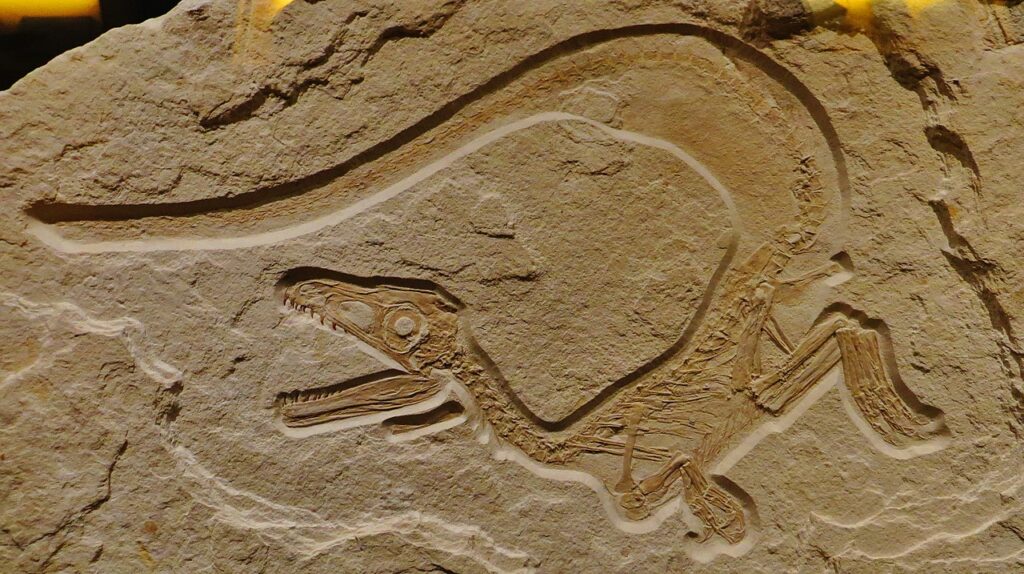
Discovered in Germany, scientists firmly place Sciurumimus in the theropod group of dinosaurs. But beyond this, much debate ensues. Part of the difficulty comes from the fact that the only known specimen of this dinosaur is a juvenile. The skeletal anatomies of most animals change as they grow. For example, baby humans have a much larger head in proportion to the size of the rest of their bodies. This makes it extremely difficult to place into a taxonomic group because we do not know how its skeleton would change as it developed into an adult.
But Sciurumimus is noteworthy because it is one of the least bird-like theropods that preserves feathers.16 The feathers of this animal resemble that of Dilong, and they occur along Sciurumimus’ tail and other parts of its body. Sciurumimus’ name means “squirrel mimic” because the feathers on its tail look like that of a tree squirrel’s tail.
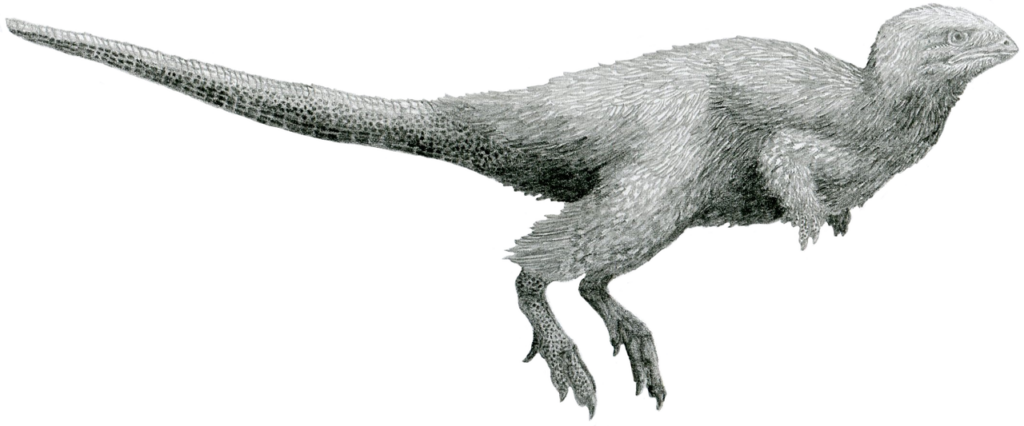
So far, we have seen dinosaurs almost completely covered in either scales or feathers. Kulindadromeus, found in Russia and announced in 2014, had scales covering its tail.17 But the rest of its body appears to have been covered in down-like feathers! They are virtually identical to those found in Sinosauropteryx. The discovery of Kulindadromeus was surprising for paleontologists because unlike most feathered dinosaurs, it was not a theropod. In fact, it has more in common with herbivorous dinosaurs such as Triceratops, hadrosaurs, and pachycephalosaurs.
Are Dinosaurs The Only Animals with Feathers?
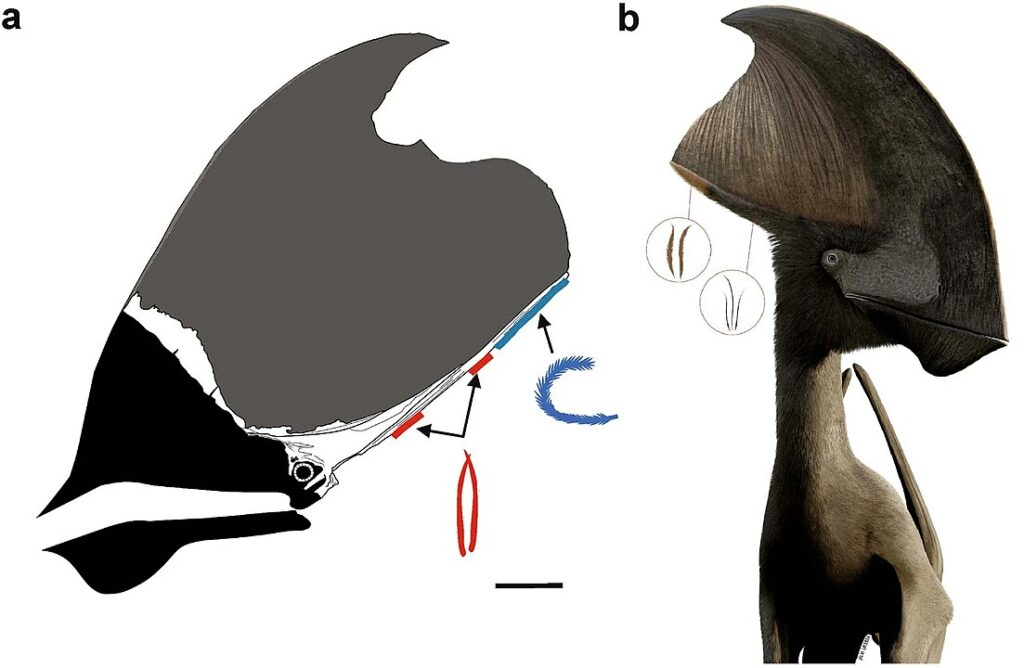
As if the discovery of feathered dinosaurs was not incredible enough, we now know that the presence of feathers is not limited to dinosaurs. It appears they were also present in other varieties of Ornithodira: the pterosaurs (flying reptiles)! Scientists have known of fossils showing that pterosaurs had a coat of fine filaments for quite some time. However, unsure of what they really were, researchers referred to the filaments as “pycnofibers” until they could make a proper identification. However, in 2022, researchers reported a well-preserved pterosaur called Tupandactylus with vaned, branching feathers along the base of its head crest.18 Pterosaurs did not merely have feather-like body coverings, they were feather body coverings. Like many of the dinosaurs, these feathers were not for flight, but helped the animal keep warm.
Conclusion
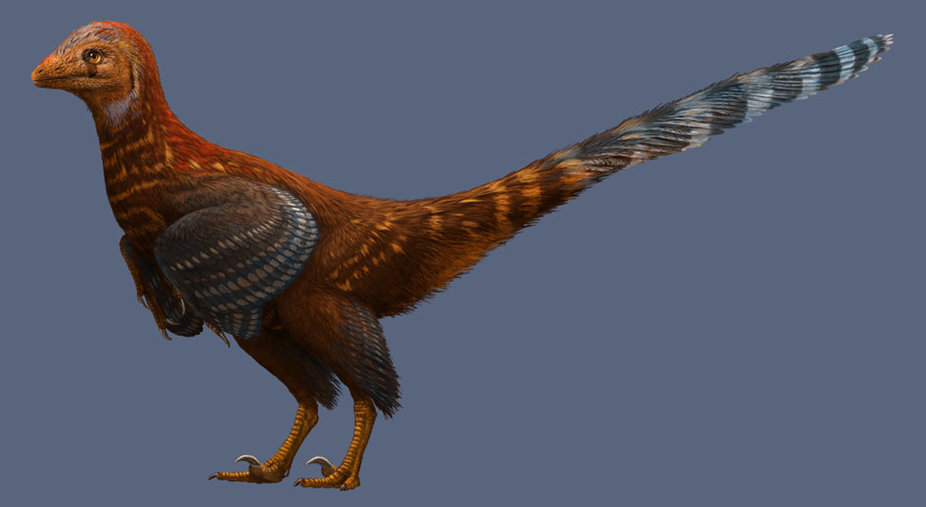
Evolutionary paleontologists were originally excited by the discovery of feathered dinosaurs. They thought it would help unlock mysteries about how feathers and powered flight evolved in birds. However, as shown here, feathers are not limited to bird-like dinosaurs any more than they are limited to birds themselves. Creatures throughout the dinosaur group exhibit feathers, and even beyond them in pterosaurs. Recall that the group Ornithodira contains both dinosaurs and pterosaurs.
The existence of feathers in so many types of ornithodirans has caused some paleontologists to wonder whether feathers are a characteristic of all members of this group. If so, this would be similar to how hair is a characteristic of all mammals. This does not mean we should start envisioning fluffy sauropods or a fuzzy, rainbow-colored T. rex. After all, we have skin impressions from plenty of dinosaurs that had extensive body coverings of scaly skin. However, we might hypothesize that feathers were at the very least present in all ornithodirans, just as hair is present in all mammals. While elephants are mostly hairless, they have “peach fuzz” on some parts of their bodies, and long hair on their tails. Likewise, whales are well-known for their hairless skin, but all are born with tiny whiskers on their snouts. Some species retain these into adulthood.
The presence of feathers on dinosaurs may be a surprising one. However, it is just another wonderful example of God expressing His glory and creativity in the things He has made. In the final part of this series, we will address how feathered dinosaurs fit into a young-earth creationist perspective. But first in part four, we will examine feathers in detail and address feather-related arguments.
Feathered By Design Series
It Started with a Feather? (Part I)
Maws, Claws, and Classification Laws (Part II)
Much Ado About Feathers (Part IV)
According to Their Kinds (Part V)
Footnotes
- Pei, Rui, Michael Pittman, Pablo A. Goloboff, T. Alexander Dececchi, Michael B. Habib, Thomas G. Kaye, Hans CE Larsson, Mark A. Norell, Stephen L. Brusatte, and Xing Xu. Pei, R., Pittman, M., Goloboff, P. A., Dececchi, T. A., Habib, M. B., Kaye, T. G. (2020). “Potential for powered flight neared by most close avialan relatives, but few crossed its thresholds.” Current Biology, 30(20), 4033-4046. ↩︎
- Li, Quanguo, Ke-Qin Gao, Qingjin Meng, Julia A. Clarke, Matthew D. Shawkey, Liliana D’Alba, Rui Pei, Mick Ellison, Mark A. Norell, and Jakob Vinther. (2012). “Reconstruction of Microraptor and the evolution of iridescent plumage.” Science 335, no. 6073: 1215-1219. ↩︎
- Lü, Junchang; Brusatte, Stephen L. (2015). “A large, short-armed, winged dromaeosaurid (Dinosauria: Theropoda) from the Early Cretaceous of China and its implications for feather evolution.” Scientific Reports. 5: Article number 11775. ↩︎
- Qiang, J., Currie, P. J., Norell, M. A., & Shu-An, J. (1998). “Two feathered dinosaurs from northeastern China.” Nature, 393(6687), 753-761. ↩︎
- Roy, A., Pittman, M., Saitta, E. T., Kaye, T. G., & Xu, X. (2020). “Recent advances in amniote palaeocolour reconstruction and a framework for future research.” Biological Reviews, 95(1), 22-50. ↩︎
- Altangerel, P., Norell, M. A., Chiappe, L. M., & Clark, J. M. (1993). “Flightless bird from the Cretaceous of Mongolia.” Nature, 362(6421), 623-626. ↩︎
- Sereno, Paul (2001). “Alvarezsaurids: Birds or ornithomimosaurs?”. In Gauthier, Jacques; Ostrom, John H. (eds.). New Perspectives on the Origin and Early Evolution of Birds. Peabody Museum of Natural History Yale University. ISBN 978-0-912532-57-8. ↩︎
- Schweitzer, M.H., J.A. Watt, R. Avci, L. Knapp, L. Chiappe, M. Norell & M. Marshall. (1999). “Beta-keratin specific immunological reactivity in feather-like structures of the Cretaceous alvarezsaurid, Shuvuuia deserti.” Journal of Experimental Zoology (Mol Dev Evol), 285: 146-157. ↩︎
- Xu, X.; Norell, M. A.; Kuang, X.; Wang, X.; Zhao, Q.; Jia, C. (2004). “Basal tyrannosauroids from China and evidence for protofeathers in tyrannosauroids” (PDF). Nature. 431 (7009): 680–684. ↩︎
- Xu, X., Wang, K., Zhang, K., Ma, Q., Xing, L., Sullivan, C., Hu, D., Cheng, S. and Wang, S. (2012). “A gigantic feathered dinosaur from the Lower Cretaceous of China.” Nature, 484(7392), pp.92-95. ↩︎
- Zhang, L., Yin, Y., & Wang, C. (2021). “High‐Altitude and Cold Habitat for the Early Cretaceous Feathered Dinosaurs at Sihetun, Western Liaoning, China.” Geophysical Research Letters, 48(14), e2021GL094370. ↩︎
- Chen, P. J., Dong, Z. M., & Zhen, S. N. (1998). “An exceptionally well-preserved theropod dinosaur from the Yixian Formation of China.” Nature, 391(6663), 147-152. ↩︎
- Zhang, Fucheng, Stuart L. Kearns, Patrick J. Orr, Michael J. Benton, Zhonghe Zhou, Diane Johnson, Xing Xu, and Xiaolin Wang. (2010). “Fossilized melanosomes and the colour of Cretaceous dinosaurs and birds.” Nature, 463(7284), 1075-1078. ↩︎
- Smithwick, F. M., Nicholls, R., Cuthill, I. C., & Vinther, J. (2017). “Countershading and stripes in the theropod dinosaur Sinosauropteryx reveal heterogeneous habitats in the Early Cretaceous Jehol Biota.” Current Biology, 27(21), 3337-3343. ↩︎
- Ji, S., Ji, Q., Lu J., and Yuan, C. (2007). “A new giant compsognathid dinosaur with long filamentous integuments from Lower Cretaceous of Northeastern China.” Acta Geologica Sinica, 81(1): 8-15 ↩︎
- Rauhut, O. W., Foth, C., Tischlinger, H., & Norell, M. A. (2012). “Exceptionally preserved juvenile megalosauroid theropod dinosaur with filamentous integument from the Late Jurassic of Germany.” Proceedings of the National Academy of Sciences, 109(29), 11746-11751. ↩︎
- Godefroit, P., Sinitsa, S.M., Dhouailly, D., Bolotsky, Y.L., Sizov, A.V., McNamara, M.E., Benton, M.J. and Spagna, P. (2014). “A Jurassic ornithischian dinosaur from Siberia with both feathers and scales.” Science, 345(6195), pp.451-455. ↩︎
- Cincotta, A., Nicolaï, M., Campos, H.B.N., McNamara, M., D’Alba, L., Shawkey, M.D., Kischlat, E.E., Yans, J., Carleer, R., Escuillié, F. and Godefroit, P. (2022). “Pterosaur melanosomes support signalling functions for early feathers.” Nature. 604 (7907): 684–688. ↩︎

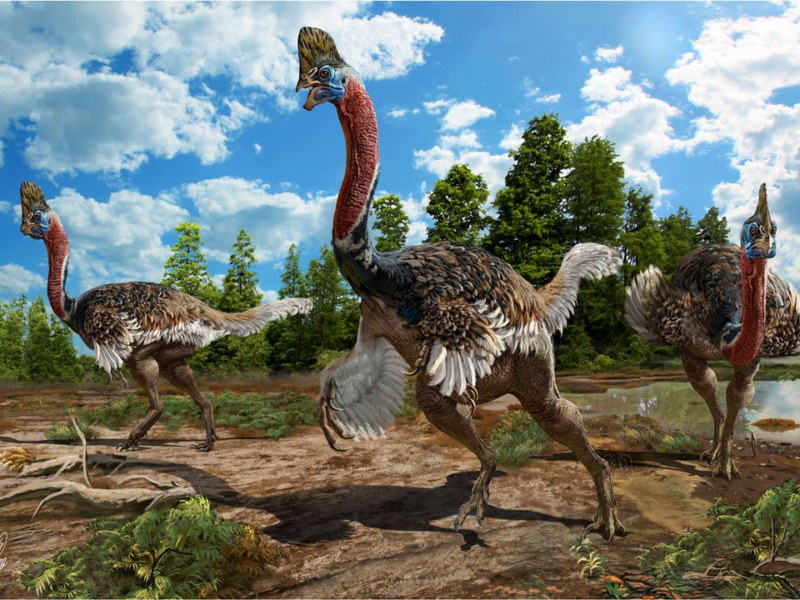




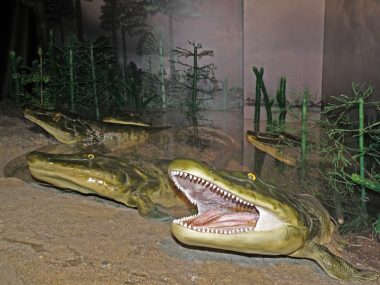
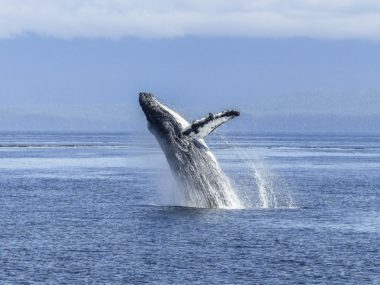




Loads of great information. Well done. however I suggest to you the option that these are just flightless ground birds in a spectrum of diversity. Critters so close to looking like birds, traits like birds, and feathers and wishbones should suggest a option they are just dumb old birds. Why not? Why agree with the invention they are flying lizards or they are a group created by god called dinosaurs. Why should God create such a group and so alike to birds?
I am confident they are just birds.Remember you said there were flying birds with teeth. Well if they became flightless would you know the difference between them and this or that theropod.?? NO! Yes feathers are likely. No they were no flying reptiles or flying dinosaurs. the simple first answer should be they are birds of a feather. Anyways this helps push forward what organized creationism must think about.
Good article Ryan.

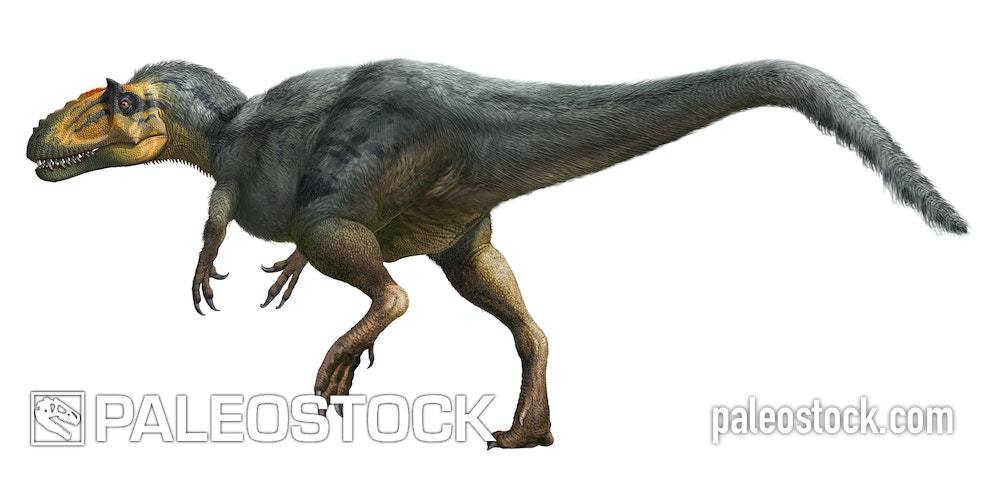 ?v=1659225829
?v=1659225829
I think some (not all) dinosaurs and pterosaurs had feathers. But I don’t think they looked like birds like in the artistic representations but like reptiles with feathers from their heads to their backs (and even their tails) and on their arms like in these images.
Of course, these artistic representations are speculative and we don’t know 100% what they were like, since we don’t have living (non-avian) dinosaurs.
I say this because it would cause confusion, and I don’t believe that God created a creature that is not.
I think that the Biblical creationists could classify the birds as a suborder of dinosaurs (but still keeping the class Aves) as with the mammals that they also classify as synapsids.
thThere is no evidence for dinosaurs. They are a invented term for creatures found in fossils but not seen. So errors are possible back in the day. aS we get smarter and better tools the THEROPOD so called dinosaurs become so birdlike there is no reason to deny they are birds which are existing kinds. its not birds are in a dino group but they are birds. why would god create dinosaurs?